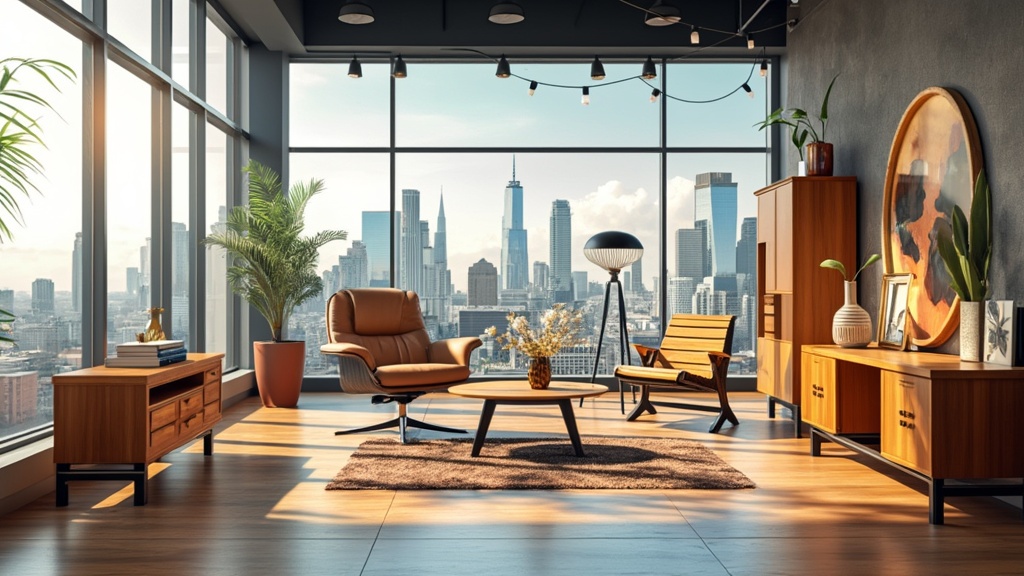Artisan Furniture USA merges traditional craftsmanship and modern aesthetics to create unique pieces that transform spaces. Handcrafted wood furniture not only reflects artistry but also emphasizes functionality, appealing to the contemporary consumer.
The growing trend toward bespoke furniture aligns seamlessly with the shift towards sustainable home decor, highlighting the desire for custom design options.
Unique styles are crafted with high-quality materials, attracting individuals who seek originality.
As customers increasingly prioritize sustainable choices, Artisan Furniture USA stands out by offering eco-friendly, tailored furnishings that enhance both residential and commercial environments.
Click here to learn more about: resale certificate connecticut ct
Artisan Craftsmanship in Focus
The evolution of artisan craftsmanship reflects changes in technology and consumer preferences. While modern demands shape the marketplace, traditional techniques remain essential for maintaining the quality and authenticity of handmade furniture.
Noteworthy regions exemplify these artisan skills:.
- Scandinavia: Minimalist designs emphasize functionality while utilizing clean lines.
- Japan: Intricate joinery and meticulous detailing showcase time-honored practices.
These areas are celebrated for their artisan skills, which blend heritage with modern innovation, ensuring that craftsmanship traditions endure. Enhanced sustainability is achieved through the use of reclaimed wood and organic materials, reinforcing the significance of these practices in today’s eco-conscious marketplace. The dedication to craftsmanship excellence ensures that each piece is not only artistic but also functional, providing comfort and versatility.

What Makes Furniture Unique
The uniqueness of furniture lies significantly in the materials that define its creation, blending aesthetics with durability. Artisan Furniture USA offers a diverse range of materials, including reclaimed wood and metals, which contribute to the distinct character of each piece.
Handcrafted wood furniture showcases unique grain patterns and colors that make every item one-of-a-kind.
Design choices also play a significant role in personal expression; custom designs allow individuals to project their personal style and lifestyle preferences.
To discover unique pieces, consider sourcing from local artisans and combining various styles, thus creating tailored decor that tells a personalized story.
The Role of Materials in Furniture Design
The interplay of materials influences not just aesthetics but also durability and functionality. For instance, the use of organic materials like bamboo is becoming popular for its ecofriendly attributes.
Each material brings its own story and texture, adding depth to furniture design.
Design as a Reflection of Personal Expression
Design choices are paramount in expressing individuality. Contemporary pieces can incorporate elements from traditional techniques, achieving a unique style that resonates with the owner.
Personalization is achievable through selecting colors, textures, and finishes that align with one’s lifestyle.
Finding Unique Pieces
- Explore local artisans for handcrafted options.
- Mix and match different styles and materials.
- Consider pieces that have a history, such as heirloom furniture.
The Benefits Of Sustainable Materials
The choice to utilize sustainable materials in furniture production directly influences environmental preservation efforts. Ecofriendly resources significantly minimize resource depletion while reducing landfill waste. A prime example is bamboo, a fast-growing material recognized for its strength and versatility, whereas reclaimed wood adds unique character and promotes recycling efforts. High-quality sustainable materials enhance the longevity of furniture, thereby reducing the need for frequent replacements.
Longevity and Durability of Sustainable Furniture
Handcrafted furniture often benefits from superior craftsmanship, leading to exceptional durability. Choosing sustainable options not only supports ethical manufacturing practices but also contributes to a healthier planet.
Popular Sustainable Materials
Many materials are gaining traction in sustainable furniture design:.
- Bamboo: Known for its rapid growth and durability.
- Reclaimed Wood: Adds character and eco-consciousness.
- Natural Fibers: Used in upholstery and accessories for their sustainability.
Unique Furniture
- Handcrafted furniture often features unique grain patterns, ensuring that no two pieces are identical.
- Using reclaimed wood not only adds character but also reduces the demand for new timber, promoting sustainability.
- Ecofriendly materials like bamboo can grow up to 3 feet in a single day, making them a highly renewable resource.
- Personalized furniture design allows individuals to reflect their unique style and preferences in their living spaces.
How Custom Design Enhances Functionality
Custom design significantly elevates functionality by ensuring that pieces are crafted to meet specific spatial requirements. Artisans prioritize tailored solutions that reflect the unique characteristics of the space.
For instance, a handcrafted dining table designed to fit snugly within a small kitchen nook not only saves valuable space but also markedly improves usability.
Artisans frequently incorporate unique features, such as built-in storage or adjustable components, enhancing the overall user experience.
Custom designs empower homeowners to optimize layouts, achieving a balance of practicality and elegance.
Practical Examples of Enhanced Usability
- Custom shelving: Designed to fit perfectly into an awkward corner, maximizing vertical space while providing functionality.
- Multi-functional furniture: A bespoke sofa that converts into a bed, catering to both comfort and space-saving needs.
- Tailored cabinetry: Incorporating personalized storage solutions that cater to specific kitchen tools or dining ware.
Timeless Styles In Artisan Furniture
Timeless styles reflect enduring designs that seamlessly integrate with contemporary home decor trends. These classic pieces utilize quality materials and exceptional craftsmanship, ensuring they remain relevant in a dynamic market. Investing in such furnishings not only ensures longevity but also promotes appreciation over time, contrasting starkly with fleeting fashions.
When incorporating timeless pieces into modern spaces, consider the following:
Tips for Blending Timeless and Contemporary Designs
- Pairing styles: Combine a vintage wooden coffee table with contemporary seating for a balanced aesthetic.
- Mixing materials: Use reclaimed wood alongside metal accents to create a harmonious yet striking look.
- Accessorizing: Integrate modern accessories with traditional furniture to bridge the gap between eras.
This thoughtful approach enhances the overall charm of your home while showcasing the artistry of local artisans. Timeless designs serve as a testament to craftsmanship excellence, connecting heritage with modern functionality.
| Feature | Benefit |
|---|---|
| Custom Shelving | Maximizes vertical space in awkward corners |
| Multi-functional Furniture | Provides comfort while saving space |
| Tailored Cabinetry | Offers personalized storage solutions for specific items |
| Timeless Styles | Ensures longevity and appreciation over time |
Why Choose Local Artisans For Your Home
Choosing local artisans for your home transforms your space into a haven of unique pieces that showcase exceptional craftsmanship. Investing in handcrafted items not only enhances quality but also supports community economies.
Research indicates that for every $100 spent at a local business, $68 stays within the community, while only $43 remains when patronizing national chains.
Local artisans prioritize quality over mass production, ensuring that each piece reflects an artistic touch imbued with personal care.
Artisan markets, such as Crafts on Columbus in New York or the Renegade Craft Fair in Chicago, offer opportunities to discover custom design options that resonate with your aesthetic preferences.
Engaging with these local furnishings enriches your living space while also providing a narrative that embodies your style and values.
Exploring Quality Assurance In Craftsmanship
Assessing the excellence of craftsmanship is essential when selecting home decor. Artisan-made products frequently utilize sustainable materials, enhancing both their durability and aesthetic appeal.
Standards such as FSC (Forest Stewardship Council) certifications ensure the ethical sourcing of materials, contributing to an eco-conscious approach to design.
When you choose artisan products, you are investing not just in an item, but in a story that has been carefully crafted.
Artisan guilds also promote adherence to high standards of craftsmanship excellence, which can be a guiding factor in your purchasing decisions. When shopping, closely examine the finishes and joins of each piece to ensure they meet your expectations.
Engaging directly with artisans allows you to inquire about their sourcing practices and the traditional techniques employed in their creations.
By emphasizing quality assurance, you empower yourself to make informed choices, leading to the selection of beautiful, long-lasting furnishings that elevate the comfort and versatility of your living environment.
- Investing in local artisans keeps $68 of every $100 spent within the community.
- Artisan-made products often use sustainable materials, enhancing durability and aesthetic appeal.
- Artisan guilds uphold high standards of craftsmanship excellence, ensuring quality in products.
- Engaging with artisans allows for direct inquiries about sourcing practices and traditional techniques.
The Role Of Community Support In Artisan Production
Community networks serve as the backbone for artisan success, fostering a nurturing environment for local artisans to thrive. These networks are pivotal in providing artisans access to essential resources that can significantly enhance their production capabilities.
By establishing shared marketing platforms and encouraging collaborative workshops, artisans are empowered to expand their reach and improve their skills.
For instance, initiatives like The Artisan Collective exemplify how community engagement increases visibility for handmade products while promoting sustainable practices.
These initiatives focus on the importance of quality craftsmanship and ethical manufacturing, helping artisans develop a strong market presence.
Local farmers’ markets offer artisans a direct outlet to showcase their unique pieces and connect with customers, reinforcing local production.
Successful Community-Supported Initiatives
The impact of community support is further illustrated through various successful initiatives that have emerged in artisan production. Local production hubs, for example, create spaces where artisans can collaborate and share resources, allowing for custom design opportunities that elevate their artistry.
In these environments, artisans are encouraged to explore innovative approaches to their crafts while maintaining a focus on traditional techniques that highlight heritage.
Community-supported agriculture models have shown that when people invest in local artisans, the entire ecosystem benefits. Artisans, such as those working with reclaimed wood or natural fibers, have found a loyal customer base eager to support eco-conscious practices.
This relationship not only bolsters the economic viability of the artisans but also fosters a sense of community pride and shared responsibility towards sustainability.
Through these community-supported initiatives, artisans can achieve craftsmanship excellence while contributing to the local economy and environmental sustainability.
The collaborative spirit within these networks cultivates an environment where artisans are not just producers but also active participants in a larger social movement striving for a sustainable future.
Community Support in Artisan Production
- Community networks provide essential resources that enhance artisans’ production capabilities.
- Initiatives like The Artisan Collective promote visibility for handmade products and sustainable practices.
- Local production hubs facilitate collaboration and resource sharing among artisans, fostering innovation.
- Community-supported agriculture models create loyal customer bases for eco-conscious artisans, enhancing economic viability.
Connecticut Resale Certificate Simplifies Wholesale Furniture Reselling



